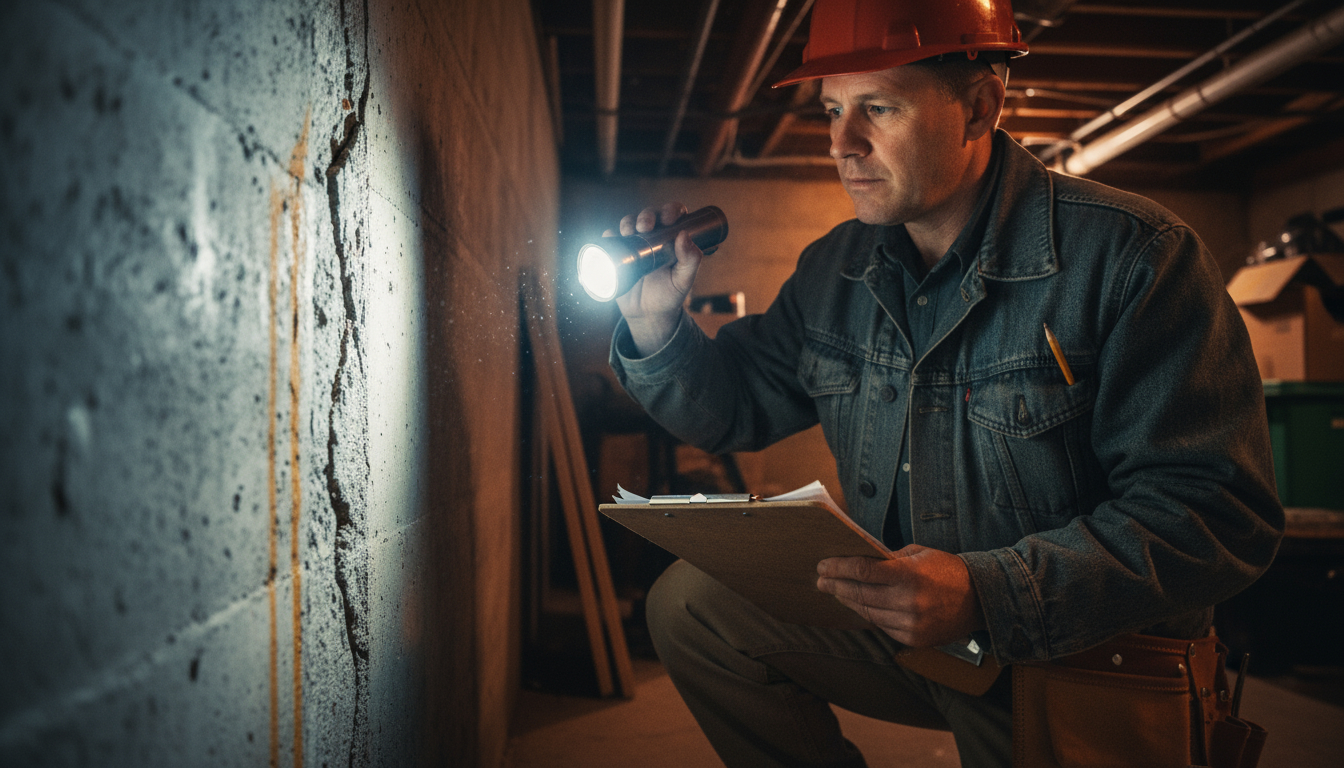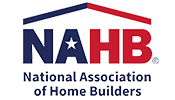What is Structural Damage Repair?
Structural damage repair encompasses the specialized processes used to restore a building’s load-bearing components to safe, functional condition. Unlike cosmetic repairs, structural restoration addresses the fundamental elements that keep your property standing—foundations, support beams, load-bearing walls, and floor systems. Understanding the scope of structural damage repair helps property owners make informed decisions when problems arise.
The structural system of any building works as an interconnected network. Foundation walls support the structure above, floor joists distribute weight evenly, and load-bearing walls transfer forces downward. When one component fails, the entire system becomes compromised. Think of it like a chain—one weak link affects the strength of the whole.
Professional building damage repair goes beyond surface fixes. Engineers assess how damage impacts the entire structural system, designing repair strategies that address root causes while reinforcing weakened areas. This holistic approach ensures repairs last for decades, not just years.
Common Types of Structural Damage
Foundation Issues
Foundation repair represents one of the most critical aspects of structural restoration. Foundation problems manifest in several ways, each indicating different underlying issues. Horizontal cracks often signal excessive lateral pressure from soil or water. Vertical cracks may indicate normal settling or more serious differential movement. Stair-step cracks in brick or block foundations typically point to significant settlement or heaving that requires professional structural damage repair.
Foundation settlement occurs when soil beneath the foundation compresses unevenly, causing portions of the structure to sink. Heaving happens when expansive soils or frost push foundations upward. Both conditions create stress throughout the building, leading to doors that won’t close, windows that stick, and floors that slope noticeably.
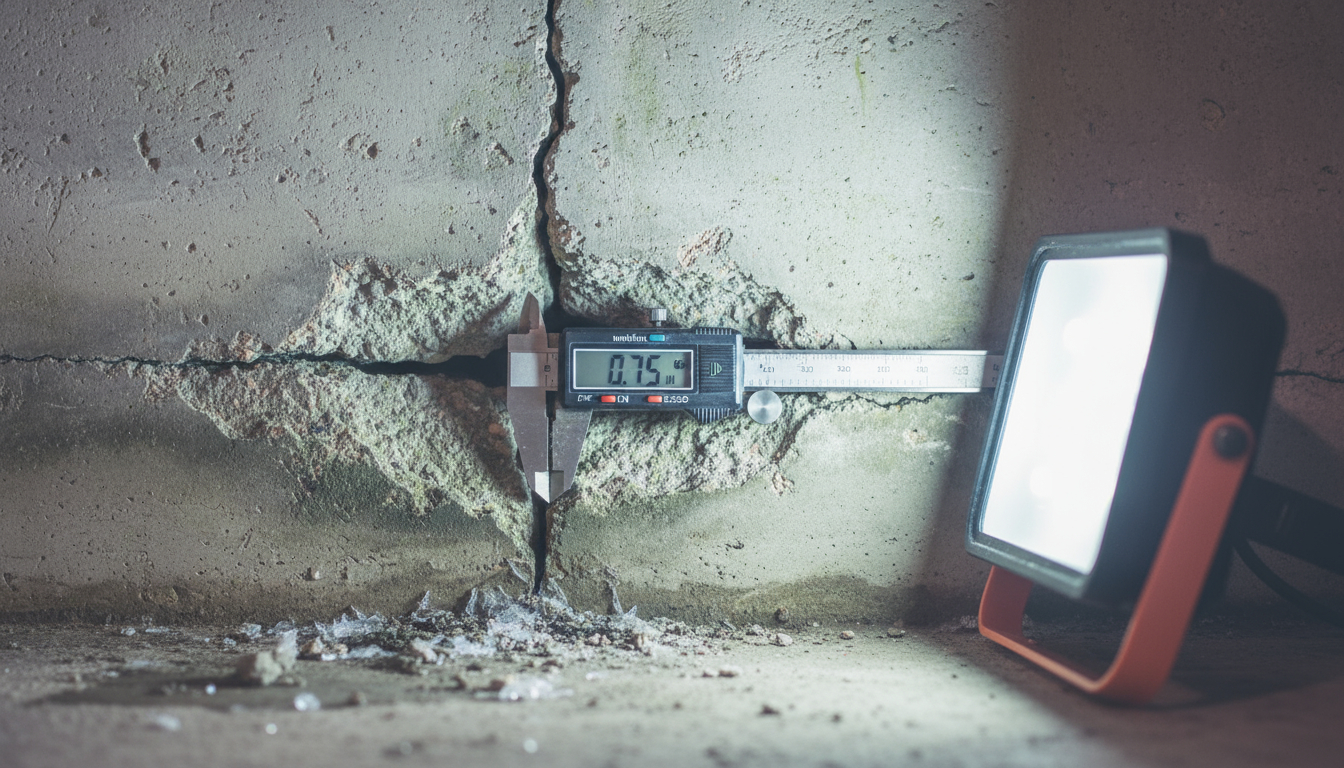
Load-Bearing Wall Damage
Load-bearing walls carry the weight of floors and roofs above them. When these walls crack, bow, or shift, the entire structure becomes unstable and requires immediate structural damage repair. Water damage from leaks or floods can weaken wall studs and bottom plates, compromising their ability to support vertical loads. Fire damage destroys the structural integrity of wood framing and can weaken steel components.
Signs of load-bearing wall problems include large cracks extending from ceiling to floor, doors and windows that become progressively harder to operate, and visible bowing or leaning. These issues require immediate professional assessment, as delayed repairs can lead to catastrophic failure.
Floor System Failures
Floor joists and beams create the platform for each level of your building. When these components sag, crack, or rot, floors become bouncy, uneven, or dangerously weak. Wood-destroying organisms like termites and carpenter ants can hollow out floor joists over time. Water damage from plumbing leaks or ground moisture causes wood to rot and steel to corrode, often leading to mold growth that requires professional remediation.
A failing floor system often announces itself through noticeable bounce when walking, sloping floors that cause objects to roll, or visible sagging from below. In severe cases, floors may feel spongy or emit cracking sounds under normal use.
| Damage Type | Common Causes | Warning Signs | Urgency Level |
|---|---|---|---|
| Foundation Cracks | Settlement, soil pressure, water infiltration | Horizontal or stair-step cracks, doors sticking | High |
| Wall Bowing | Lateral soil pressure, water damage | Visible inward lean, separation from ceiling | Critical |
| Beam Failure | Overloading, rot, termite damage | Sagging floors, cracking sounds | High |
| Roof Structure | Age, weather damage, improper installation | Sagging roof line, interior water stains | Medium-High |
Primary Causes of Structural Damage
Water-Related Issues
Water ranks as the leading cause of structural problems in residential and commercial properties, making water-related structural damage repair one of the most common restoration needs. Groundwater pressure against foundation walls creates lateral forces that cause bowing and cracking. Poor drainage directs water toward foundations, where it saturates soil and increases pressure. Plumbing leaks within walls and beneath floors quietly destroy structural components over months or years.
Flooding events deliver catastrophic water damage in hours. Standing water weakens foundations, saturates wood framing, and can undermine soil support beneath buildings. Professional water cleanup and extraction services are essential after flooding to prevent progressive structural deterioration. The freeze-thaw cycle in cold climates compounds water damage—water enters cracks, freezes and expands, then widens those cracks further with each cycle.
Soil Movement and Settlement
The ground beneath buildings is constantly moving, though usually imperceptibly. Clay soils expand when wet and shrink when dry, creating cyclical stress on foundations that eventually requires structural damage repair. Poorly compacted fill soil slowly compresses under the weight of structures, causing differential settlement. Nearby construction or heavy equipment operation can compact soil and create voids beneath existing foundations.
Regions with high water tables experience seasonal soil movement as groundwater levels rise and fall. Properties built on hillsides face additional challenges from soil creep and potential landslides. Understanding your property’s soil conditions helps predict and prevent structural issues that would necessitate costly structural damage repair.
Environmental Factors
Natural disasters create immediate, obvious structural damage that requires emergency structural damage repair services. Earthquakes generate lateral forces that buildings weren’t designed to resist, causing foundation shifting and wall failures. High winds from hurricanes and tornadoes lift roofs and push against walls with tremendous force. Wildfires don’t just burn structures—extreme heat weakens steel components and destroys the integrity of concrete, requiring comprehensive fire and smoke damage restoration.
Long-term environmental exposure also takes its toll. Years of moisture exposure rot wood components and corrode metal fasteners, eventually requiring structural damage repair. Ultraviolet radiation degrades roofing materials and exterior wall systems. Temperature extremes cause expansion and contraction that gradually loosens connections and widens gaps, accelerating the need for professional structural damage repair.
⚠️ Important: Never attempt structural damage repair yourself. Building damage repair requires specialized knowledge of load paths, material strengths, and building codes. Improper repairs can make problems worse or create new hazards.
The Structural Damage Assessment Process
Initial Inspection
Professional structural restoration begins with comprehensive inspection by qualified engineers or contractors. Every successful structural damage repair project starts with accurate assessment of the problem’s scope and severity. Inspectors examine every accessible area—foundations, crawl spaces, attics, and interior spaces. They document crack patterns, measure deflections, and note any previous repair attempts. This initial assessment identifies immediate safety concerns and determines whether the building is safe to occupy.
Modern inspection technology includes laser levels for measuring precise elevations, moisture meters to detect hidden water damage, and thermal imaging cameras that reveal temperature differences indicating structural problems. These tools help inspectors see beyond visible symptoms to underlying causes, providing a complete picture of the structural damage repair needs. Advanced diagnostic equipment ensures no hidden damage goes undetected during the structural damage repair assessment process.
Structural Engineering Evaluation
For significant damage, structural engineers conduct detailed analysis of load-bearing capacity and failure modes. Engineers calculate whether damaged components can still support required loads or if temporary shoring is needed. They determine whether damage stems from design deficiencies, construction errors, or external forces. This evaluation produces specific structural damage repair recommendations with engineering calculations to support permit applications.
The engineering report becomes your roadmap for structural damage repair. It prioritizes issues by urgency, outlines repair methodologies, and provides specifications that contractors use to bid accurately on structural damage repair projects. Insurance companies typically require engineering reports for substantial structural claims.
Soil Testing and Foundation Analysis
When foundation repair is needed, soil analysis determines the cause and appropriate solution. Geotechnical engineers bore soil samples to evaluate composition, bearing capacity, and moisture content. They measure seasonal movement patterns and assess whether soil can adequately support existing or new foundation elements needed for effective structural damage repair.
Testing may reveal expansive clays that require special foundation designs, weak soils that need underpinning, or high water tables requiring improved drainage. This information ensures structural damage repair strategies address root causes rather than just symptoms, providing long-lasting solutions.
💡 Pro Tip: Request documentation of all inspection findings, including photographs and measurements. This baseline information helps you monitor whether problems worsen over time and provides valuable data for future buyers if you sell the property.
Modern Structural Repair Techniques
Foundation Stabilization Methods
Steel push piers and helical piers provide permanent foundation support by transferring loads to competent soil or bedrock deep below the surface. These advanced methods represent the gold standard in modern structural damage repair for foundation issues. Contractors hydraulically drive push piers through weak soil until they reach load-bearing strata. Helical piers feature screw-like blades that advance into the ground, developing holding capacity through soil friction.
Once installed, pier systems can lift settled foundations back to level or stabilize them at current elevations. The process minimizes disruption to landscaping and typically completes in one to three days for residential properties. Pier systems come with warranties of 25 years or more, making them a reliable long-term structural damage repair solution.
Carbon fiber reinforcement offers an innovative solution for foundation walls experiencing bowing or cracking. Contractors epoxy high-strength carbon fiber strips to interior foundation walls, preventing further movement without excavation. This method works particularly well for walls with less than two inches of deflection and proves more economical than traditional replacement, representing a modern approach to structural damage repair.
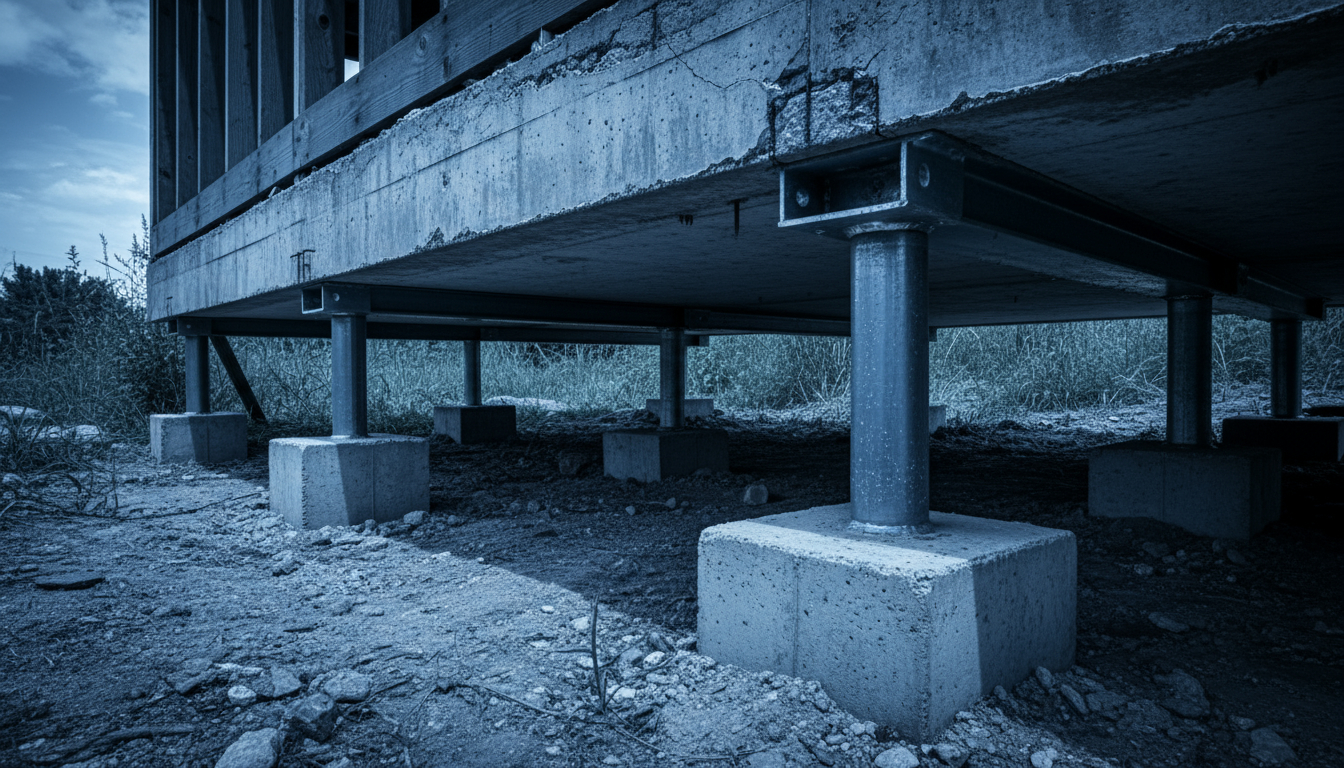
Wall and Beam Repair Solutions
Structural restoration of damaged walls varies by material and extent of damage. Professional structural damage repair contractors assess each situation individually to determine the most effective approach. Wood-framed walls may require sistering—attaching new lumber alongside damaged studs to restore strength. Masonry walls might need tuck-pointing to replace deteriorated mortar, or complete rebuilding of severely compromised sections. Steel reinforcement systems can stabilize walls without full replacement.
Damaged support beams demand careful replacement strategies that maintain support during repairs. Contractors install temporary shoring posts to carry loads while removing compromised beams. New beams—often engineered lumber or steel—replace old ones with materials rated to handle required loads plus safety factors. Proper connection details ensure new beams integrate seamlessly with existing structure, completing the structural damage repair process safely and effectively.
Advanced Repair Technologies
Polyurethane foam injection raises and stabilizes concrete slabs without the weight and disruption of mudjacking. Contractors drill small holes through slabs and inject expanding foam that fills voids and lifts concrete. The foam cures in minutes and adds minimal weight to underlying soils. This technique works for driveways, garage floors, and basement slabs, providing efficient structural damage repair for settled concrete.
Epoxy injection repairs foundation cracks from the inside out. Contractors inject liquid epoxy deep into cracks under pressure, filling the entire crack width from front to back. The epoxy cures harder than surrounding concrete, creating a permanent waterproof seal. This method restores structural integrity while preventing future water infiltration, making it an essential tool in modern structural damage repair.
| Repair Method | Best Applications | Typical Duration | Longevity |
|---|---|---|---|
| Steel Piers | Settled foundations, unstable soil | 1-3 days | 25+ years |
| Carbon Fiber | Bowed walls, minor deflection | 1 day | Permanent |
| Beam Replacement | Rotted or damaged support beams | 2-5 days | 50+ years |
| Epoxy Injection | Foundation cracks, waterproofing | 1 day | Permanent |
| Foam Lifting | Slab settlement, void filling | Few hours | 10-15 years |
Factors Affecting Repair Approach
Severity and Extent of Damage
Minor cosmetic cracks may require only epoxy injection and monitoring. Moderate structural issues might need partial reinforcement or component replacement. Severe damage affecting multiple building systems often requires comprehensive structural damage repair with extensive temporary support during the restoration process. The complexity of structural damage repair increases proportionally with the extent of the problem.
The percentage of a structure affected influences repair strategies. Isolated damage permits targeted repairs, while widespread problems may warrant systematic reinforcement of entire floor levels or foundation perimeters. Engineers consider whether addressing symptoms suffices or if underlying causes demand property-wide structural damage repair solutions.
Building Age and Construction Type
Historic buildings present unique challenges requiring specialized knowledge of period construction techniques. Original materials may no longer be available, and modern building codes may conflict with preservation requirements. Qualified restoration contractors understand how to strengthen historic structures while maintaining architectural integrity through appropriate structural damage repair techniques.
Construction type determines available repair options. Wood-frame buildings offer more flexibility for modifications than masonry structures. Steel-frame commercial buildings require different structural damage repair approaches than residential load-bearing wall systems. Material compatibility ensures repairs integrate properly with existing construction, maintaining the integrity of the structural damage repair work.
Site Conditions and Access
Limited access complicates structural damage repair projects and may require creative solutions. Crawl spaces too small for workers necessitate cutting access openings or working in extremely difficult conditions. Finished basements require removing drywall, flooring, and other finishes to reach structural components. Exterior repairs may demand extensive excavation around foundations.
Urban properties face additional constraints. Work in attached buildings must not destabilize adjoining structures. Limited staging areas challenge equipment placement and material storage. Noise and hour restrictions may extend project timelines. Experienced structural damage repair contractors plan for these obstacles when scheduling and bidding projects.
🏠 Home Tip: Take photographs of your foundation, walls, and ceilings annually to create a visual record. This documentation helps you spot gradual changes that might indicate developing structural problems.
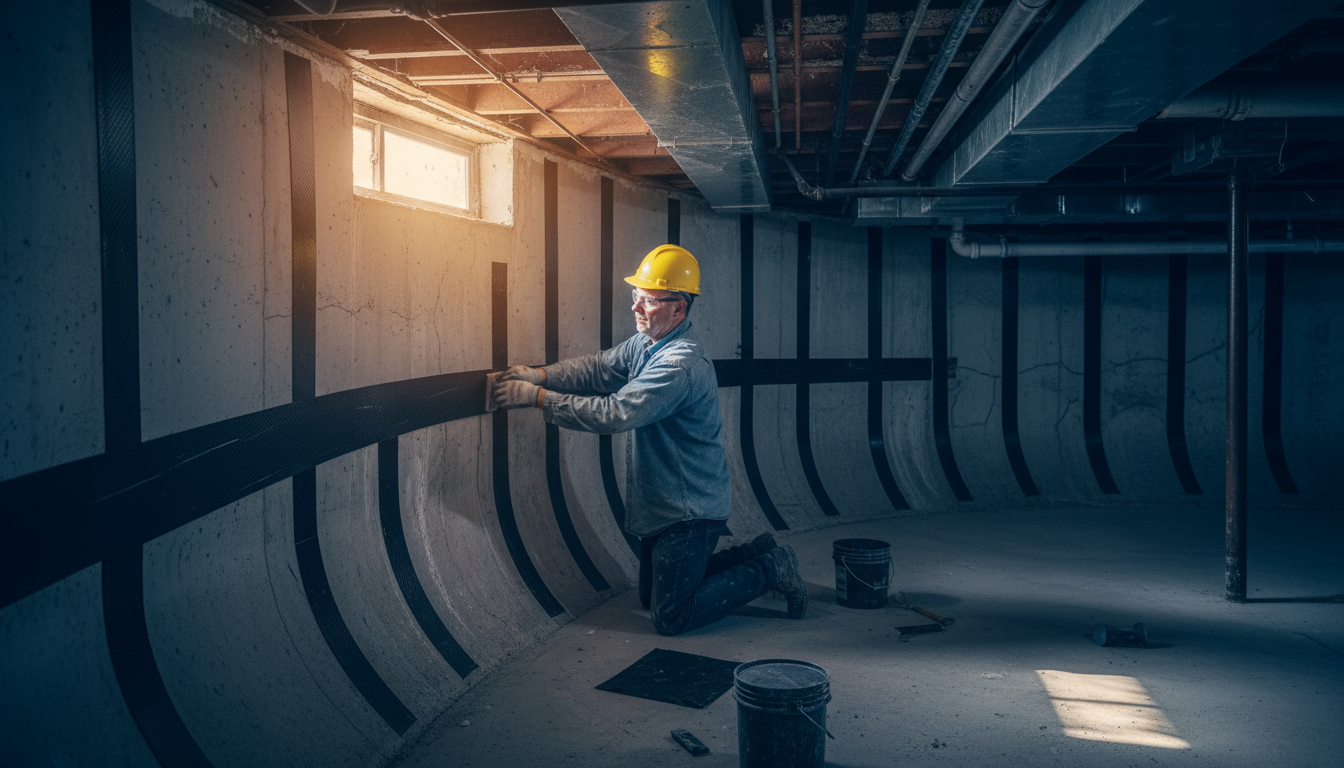
The Repair Process: What to Expect
Pre-Construction Planning
Successful structural damage repair projects begin with thorough planning. Contractors develop detailed work sequences that maintain building safety throughout repairs. They identify which areas require temporary shoring, when utilities need disconnection, and how to protect occupied spaces from dust and debris.
Permit acquisition ensures repairs meet building codes and pass inspections. Most jurisdictions require permits for structural damage repair work, with inspections at key stages. Your contractor handles permit applications using engineering drawings and specifications. Plan reviews can take several weeks in busy municipalities.
Temporary Protection and Support
Before beginning demolition or repairs, contractors install protective measures. Temporary shoring posts support loads that damaged components currently carry. Dust barriers isolate work areas from occupied spaces. Dehumidifiers control moisture if water damage contributed to structural problems. In cases of severe storm damage or security concerns, emergency board-up services protect the property during repairs. These preparations minimize disruption while ensuring safety.
For occupied buildings, contractors coordinate work schedules around normal activities when possible. Noisy demolition work might occur during business hours in commercial properties, while quiet assembly happens after hours. Clear communication helps everyone understand daily activities and any temporary inconveniences.
Execution and Quality Control
Experienced crews follow specific sequences to maintain structural integrity during repairs. Proper structural damage repair requires methodical execution where safety is never compromised. They never remove more than can be safely replaced in one work session. Each day ends with the structure adequately supported, even if work isn’t complete. This methodical approach prevents accidents and ensures consistent quality.
Throughout construction, inspectors verify work meets engineering specifications and building codes. They check that new materials match specified grades, fasteners are installed correctly, and connections develop required strengths. Multiple inspection points catch issues early, preventing costly corrections later.
Final Inspection and Documentation
Completed repairs undergo final inspection by building officials and often by the structural engineer who designed them. Inspectors verify all code requirements are met and issue certificates of completion for the structural damage repair work. These documents prove repairs were performed correctly and typically transfer to future property owners.
Your contractor should provide comprehensive documentation including as-built drawings showing exactly what was done, warranties for materials and workmanship, and maintenance recommendations. This information protects your investment and proves valuable when selling the property or planning future modifications that might require additional structural damage repair.
Preventing Future Structural Damage
Water Management
Effective drainage systems divert water away from foundations before problems develop, reducing the need for costly structural damage repair in the future. Gutters and downspouts should discharge at least six feet from buildings. Grade soil to slope away from foundations at minimum two percent grade. Interior and exterior drainage systems collect and redirect water before it creates pressure against foundation walls.
Regular plumbing maintenance prevents leaks that cause hidden structural damage. Inspect visible pipes annually for signs of corrosion or drips. Monitor water bills for unexplained increases indicating hidden leaks. Address minor leaks immediately before they compromise structural components and necessitate extensive structural damage repair.
Foundation Maintenance
Consistent soil moisture around foundations prevents the expansion-contraction cycles that cause cracking and necessitate structural damage repair. During dry periods, water foundation perimeters to maintain moisture levels. Avoid planting large trees within ten feet of foundations—their roots extract moisture and can damage foundation walls. Install root barriers if large trees exist near structures.
Seal foundation cracks promptly to prevent water infiltration and progressive widening. Small cracks can be sealed with quality masonry crack sealers. Larger cracks or those showing movement require professional evaluation and repair. Annual foundation inspections identify developing issues before they become serious.
Regular Professional Inspections
Annual inspections by qualified professionals catch problems early when repairs are simpler and less expensive. Inspectors check for new cracks, verify drainage systems function properly, and assess whether previous structural damage repair work remains effective. They monitor crack widths to determine if movement is ongoing or has stabilized.
Properties in areas with known soil problems benefit from monitoring programs that track foundation movement over time. Contractors install reference points and measure elevations periodically to detect settlement or heaving before it causes serious damage requiring major structural damage repair. This proactive approach minimizes repair expenses.
💡 Pro Tip: Create a “building health” file containing all inspection reports, repair documentation, and annual photographs. This record demonstrates property care to future buyers and provides valuable data for diagnosing any future issues.
When to Call Professional Structural Restoration Experts
Warning Signs Requiring Immediate Attention
Certain conditions demand immediate professional evaluation for potential structural damage repair. Call structural experts without delay if you notice sudden appearance of large cracks, rapid widening of existing cracks, or doors and windows that suddenly won’t close. Visible sagging of floors, ceilings, or rooflines indicates active structural movement requiring urgent assessment and possible emergency structural damage repair.
After natural disasters, professional inspection ensures your building is safe to occupy even if damage isn’t obvious. Earthquakes, floods, and high winds can compromise structural systems without creating visible external damage. Don’t risk occupant safety—contact 24-hour emergency restoration services for immediate assessment and get professional confirmation that structures remain sound.
Choosing Qualified Contractors
Select contractors with proven expertise in building damage repair and structural restoration. Look for companies that employ or work closely with structural engineers. Verify they carry appropriate licenses and insurance, including general liability and workers compensation coverage. Request references from recent structural damage repair projects similar to yours.
Quality contractors provide detailed written estimates explaining proposed work, materials to be used, and project duration. They answer questions clearly and help you understand why specific structural damage repair methods are recommended. Be wary of contractors who pressure quick decisions or offer prices dramatically below other bids—quality structural work requires skilled labor and proven materials.
Working with Engineers and Building Officials
Complex structural damage repair projects typically require coordination between contractors, structural engineers, and building inspectors. Engineers design repairs and provide calculations proving work meets code requirements. Building officials review plans, issue permits, and inspect work at critical stages. This team approach ensures structural damage repair work is both effective and code-compliant.
Maintain open communication with all parties throughout the project. Ask questions when you don’t understand recommendations. Request explanations of any changes to original plans. Professional contractors welcome questions and provide clear answers that help you make informed decisions about your property.
Long-Term Structural Health Monitoring
Establishing Baseline Conditions
After completing structural damage repair, document current conditions as a baseline for future comparisons. Photograph repaired areas from multiple angles. Note measurements such as crack widths, floor elevations, and wall plumb. Professional contractors often provide this documentation, but maintaining your own records adds another layer of protection.
Mark reference points that allow easy future measurements. Small adhesive markers near cracks let you monitor whether they’re growing. Note floor elevations at several points in each room. These simple measures help you detect new problems quickly that might require additional structural damage repair.
Ongoing Monitoring Protocols
Develop a regular inspection schedule appropriate for your property’s condition and history. Properties with previous structural damage repair work benefit from quarterly self-inspections and annual professional evaluations. Buildings with stable histories may need only annual self-inspections and professional evaluation every few years.
During self-inspections, look for new cracks or widening of existing ones. Check that doors and windows operate smoothly. Note any new sloping or unevenness in floors. Examine foundation walls for signs of moisture or efflorescence. Document findings with dated photographs and measurements.
Maintenance Best Practices
Consistent maintenance prevents many structural problems from developing. Clean gutters twice yearly to ensure proper water drainage. Inspect and maintain sump pumps before wet seasons. Seal basement and crawl space vents appropriately for each season. Maintain consistent moisture around foundations during dry periods.
Address minor issues promptly before they escalate into major structural damage repair needs. Small plumbing leaks should be fixed immediately. Settlement cracks smaller than one-eighth inch can be sealed with quality products. Drainage problems should be corrected when first noticed. This proactive approach minimizes major structural damage repair expenses.
⚠️ Important: Never ignore progressive structural problems hoping they’ll stabilize on their own. Structural damage typically worsens over time, with structural damage repair complexity and expense increasing proportionally. Early intervention is always more economical than delayed repair.
The Investment in Structural Integrity
Factors Affecting Project Scope
Multiple variables influence the extent and complexity of structural damage repair projects. The severity of damage determines whether simple repairs suffice or extensive reconstruction is needed. Accessibility affects labor requirements—easily reached areas cost less to repair than confined spaces requiring special equipment or techniques. Understanding these factors helps property owners budget appropriately for structural damage repair work.
Building size and complexity play significant roles. Small residential properties generally require less extensive repairs than large commercial structures with complex load-bearing systems. The number of stories affects difficulty—multi-story repairs involve more temporary support and safety measures than single-level work.
Material and Labor Considerations
Modern structural restoration employs engineered materials designed for specific applications. Steel and helical piers, carbon fiber reinforcement systems, and specialized adhesives carry higher material expenses than traditional repair products, but provide superior long-term performance and warranties for structural damage repair projects.
Skilled labor commands appropriate compensation. Structural damage repair requires experienced crews who understand load paths, proper installation techniques, and safety protocols. Quality workmanship prevents callbacks and ensures repairs last for decades. Companies investing in ongoing training and safety programs deliver superior structural damage repair results worth the investment.
Long-Term Value Considerations
Professional structural damage repair protects and enhances property value. Unrepaired structural damage causes progressive deterioration and creates disclosure obligations when selling. Documented professional repairs with warranties provide buyers confidence and may eliminate financing obstacles.
Preventive structural damage repair costs substantially less than emergency interventions. Addressing minor foundation cracks early prevents major settlement requiring extensive underpinning. Reinforcing bowing walls before they fail avoids complete reconstruction. Insurance companies often cover sudden structural damage but exclude progressive problems that weren’t addressed promptly with appropriate structural damage repair.
🏠 Home Tip: Keep detailed records of all structural work including invoices, warranties, and permits. These documents transfer to future owners and may help recover expenses through insurance claims or disaster assistance programs if applicable.
Regional Considerations for Structural Repairs
Climate-Specific Challenges
Different climates create unique structural challenges requiring specialized structural damage repair approaches. Cold regions face freeze-thaw cycling that widens cracks and damages foundations. Proper insulation and drainage prevent frost heaving and ice dam formation. Repair materials must withstand temperature extremes without losing effectiveness.
Hot, arid climates cause soil shrinkage that can undermine foundations. Consistent foundation watering during dry periods maintains soil moisture and prevents settlement. Repairs in these regions often include improved irrigation systems around building perimeters as part of comprehensive structural damage repair strategies.
High-humidity coastal areas promote wood rot and metal corrosion. Structural damage repair in these locations may require enhanced moisture barriers, rot-resistant materials, and protective coatings on metal components. Proper ventilation systems prevent moisture accumulation in enclosed spaces.
Seismic and Hurricane Zones
Properties in earthquake-prone regions benefit from seismic retrofitting during structural damage repair projects. Contractors add foundation anchor bolts, cripple wall bracing, and moment frame connections that help buildings resist lateral forces. These upgrades may qualify for insurance discounts and dramatically improve survival chances during seismic events.
Hurricane-zone properties need enhanced connection systems between roof, walls, and foundations. Metal straps and clips create continuous load paths that resist uplift forces. Impact-resistant materials protect against wind-borne debris. Structural damage repair in coastal areas should include these enhancements where applicable to protect against future storms.
Insurance and Structural Damage
Coverage Considerations
Standard property insurance policies typically cover structural damage repair costs from sudden, unexpected events like storms, fires, or plumbing failures. However, progressive damage from settlement, soil movement, or deferred maintenance usually isn’t covered. Review your policy to understand what structural damage scenarios are included and what structural damage repair work your insurance will cover.
Document damage thoroughly before beginning repairs. Take extensive photographs from multiple angles showing damage extent and affected areas. Insurance companies may send adjusters to assess damage, but your documentation protects your interests if disputes arise. Professional engineering reports strengthen insurance claims for covered damage.
Filing Claims Effectively
Report structural damage to your insurance company promptly after discovery. Delays in notification can complicate claims or provide grounds for denial. Obtain multiple structural damage repair estimates from qualified contractors to ensure fair claim settlements. Your adjuster should explain coverage determinations and how they calculated claim values.
If your claim is denied or the settlement seems inadequate, you can request re-evaluation or hire a public adjuster to advocate on your behalf. Many structural damage repair companies work regularly with insurance claims and can provide guidance through the process. Don’t proceed with repairs until insurance coverage is determined, unless emergency stabilization is necessary to prevent further damage.
Frequently Asked Questions
How do I know if structural damage is serious enough to require professional repair?
Any crack wider than one-quarter inch, cracks that are growing, or damage affecting doors and windows warrants professional evaluation. Visible sagging, bowing walls, or sloping floors indicate serious issues requiring immediate expert assessment for potential structural damage repair. When in doubt, err on the side of caution—structural engineers can determine if damage poses safety risks or will worsen without intervention.
Can I live in my home during structural repairs?
Many structural damage repair projects allow continued occupancy with some inconvenience. Your contractor will explain which areas need temporary closure and expected dust or noise levels. However, extensive repairs affecting multiple building systems may require temporary relocation for safety. Work with your contractor to minimize disruption while maintaining proper safety protocols throughout the project.
How long do structural repairs typically last?
Professional structural damage repair using quality materials and proper techniques should last for decades. Steel pier systems often carry 25-year warranties or more. Epoxy crack repairs and carbon fiber reinforcement are considered permanent solutions. The longevity depends on addressing underlying causes, using appropriate materials, and following proper maintenance protocols after repairs are complete.
Should I repair structural damage before selling my property?
Yes, completing structural damage repair before selling typically proves financially beneficial. Unrepaired structural issues must be disclosed to buyers, often resulting in reduced offers or financing difficulties. Documented professional repairs with warranties reassure buyers and prevent deal complications. The return on investment for structural damage repair usually exceeds the repair expense through higher sale prices and smoother transactions.
What’s the difference between cosmetic cracks and structural concerns?
Cosmetic cracks are typically hairline, don’t widen over time, and appear in non-structural elements like drywall or plaster. Structural cracks are wider than one-eighth inch, show progressive growth, follow building joints, or appear in load-bearing components like foundations and support beams. Stair-step patterns in masonry and horizontal cracks in concrete walls usually indicate structural issues requiring professional evaluation.
Can structural damage return after professional repair?
Properly executed structural damage repair that addresses root causes should prevent recurrence of the same damage. However, new structural issues can develop from different causes. This is why identifying and correcting underlying problems—like poor drainage or unstable soil—is crucial during repairs. Regular maintenance and monitoring help catch any new problems early before they become serious.
Protect Your Property’s Future
Structural damage repair is an investment in your property’s safety, stability, and value. Whether addressing foundation settlement, load-bearing wall damage, or other structural concerns, professional restoration ensures your building stands strong for decades to come. The key to successful structural damage repair is recognizing problems early, working with qualified professionals, and maintaining your structure properly after repairs are complete.
Advanced DRI brings decades of expertise in structural restoration and building damage repair throughout the Hudson Valley region. Our team of engineers and certified restoration specialists uses proven techniques and quality materials to restore your property’s structural integrity. We handle everything from initial assessment through final inspection, ensuring repairs meet all code requirements and manufacturer specifications for comprehensive structural damage repair. When repairs require extensive work, our full reconstruction services can restore your property to pre-loss condition.
Don’t wait for minor structural issues to become major problems. Contact Advanced DRI today for a comprehensive structural assessment. Our emergency response team is available 24/7 to address urgent structural concerns, and our detailed evaluations help you make informed decisions about protecting your property investment. Call us now to schedule your inspection and discover why Hudson Valley property owners trust Advanced DRI for their structural restoration needs.

